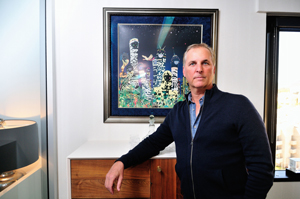
Victor Coleman grew up a huge Canucks fan in Vancouver, B.C. Today, the 54-year-old Pacific Palisades resident is trying to score a National Hockey League team for Seattle while running West L.A. real estate investment trust Hudson Pacific Properties. Coleman founded Hudson in 2006, a year after he and Richard Ziman sold Arden Realty Inc. to GE Real Estate for $3.2 billion. While others were pinching pennies during the downturn, he led Hudson on a spending spree in Hollywood, acquiring roughly 30 acres of studio space – 200,000 square feet of which is now leased by Netflix Inc. Now, Coleman has his sights set on downtown L.A.’s Arts District, where he bought four properties over the last year, including the old Coca-Cola factory. The Business Journal sat with Coleman at his office at Hudson to discuss his strategy for the Arts District, among other matters.
Tell me about your efforts to bring pro hockey to Seattle. Should we expect that you’ll be the next L.A. owner of a sports team?
I don’t know about that. I mean, listen, it’s a lot of work. We’d love to see it happen, but it’s going to take some time.
But you’re still actively pursuing it?
Yeah, we’re pursuing it.
What got you interested in the Arts District?
It was the whole lifestyle down there. Anyone who lives in the Arts District probably doesn’t care about living in Southern California, because they don’t care about going to the beach. They have everything they need right there and they love it. The true urbanization in that marketplace intrigued me.
What is your strategy in the area?
We are going to position ourselves as the landlord for high-quality office. The phrase “creative office” is overused, but we are designing and putting in place very unique and progressive working space.
How far along are you?
We’re in the design phase, anticipating that we’ll be done with the Coca-Cola building in late 2016 and the other (at 405 S. Mateo St.) in the second quarter of 2017.
On a recent earnings call, you mentioned that office rents in the area are approaching Beverly Hills’ levels. Is that sustainable?
There are only a handful of real office properties for people to occupy there and not a lot coming on line that’s office related. So that sets real estate values. When some of the amenity base comes in – Soho House and the like – it’s going to change the feel and make it a bona fide area that people are going to recognize. People are going to want to work in that area, too.
What needs to change in the Arts District for it to be as stable a market as, say, Beverly Hills?
It’s going to take a lot of time to educate people to want to be there. The irony, I think, is that L.A. is not ready for the Arts District, but the rest of the country is, so we’ll have to see how it plays out.
With land trading at such high prices in the Arts District, some say there’s a risk developments won’t pencil by the end of this cycle. What do you think?
I do think the cost of construction is high. I’d rather be an accumulator of existing assets and renovate them. I think you will get to market quicker and you can control your costs easier and can capture whatever sort of market share there is.
You bought studio space in Hollywood during the downturn. What was your vision?
We knew there would be enough media and entertainment-type tenants who want office space on an actual day-to-day lot that has access to soundstages and production facilities. So we designed around that concept. We built an office building on the edge of Sunset Gower Studios that we leased to Technicolor Inc. in 2008. It was the first new office building that was built on a Hollywood lot since the 1970s. With the Icon building, we started to design it four years ago and the intent was always to build on spec. We were very fortunate to get Netflix, which proved out our theory. Now, you’ve got awareness that the future of production is actually in Hollywood – where the history is.
You have expanded into Silicon Valley and Seattle. Where will we see Hudson next?
We’re crazy busy. We’re increasing our portfolio in Seattle. We’ve accumulated a tremendous number of assets in San Francisco. Here, we’ve got an asset in Playa Vista, one in Culver City, one here in West L.A. I think we’re pretty diversified in our core markets, and those are the markets that we are going to stay in and grow.
What is your favorite part of Los Angeles – where do you like to hang out?
I’m still a Westside guy. It’s hard to go to Hollywood or the Arts District when you have to hit traffic on a regular occurrence. I’m a convenience guy. I like the Westside.
